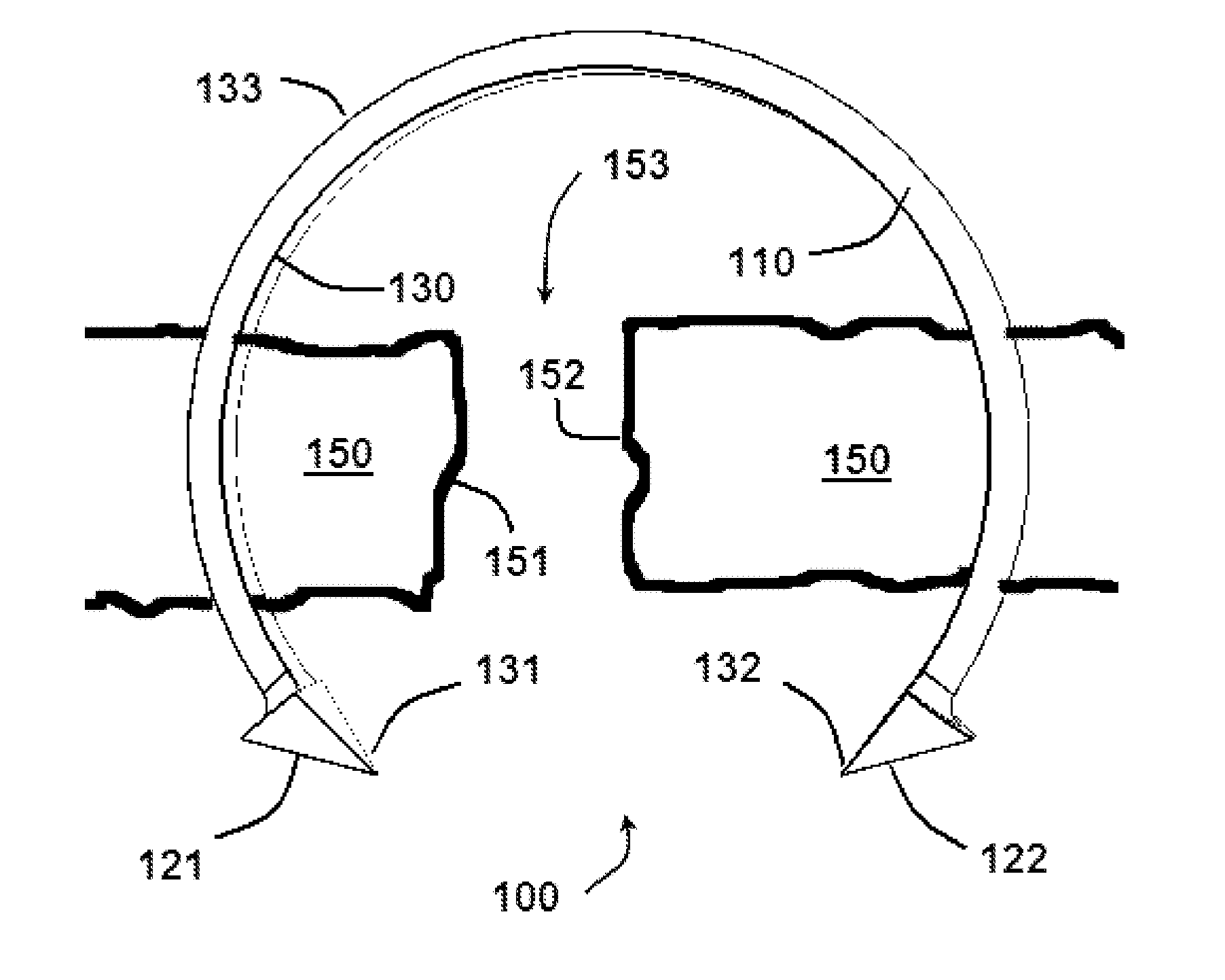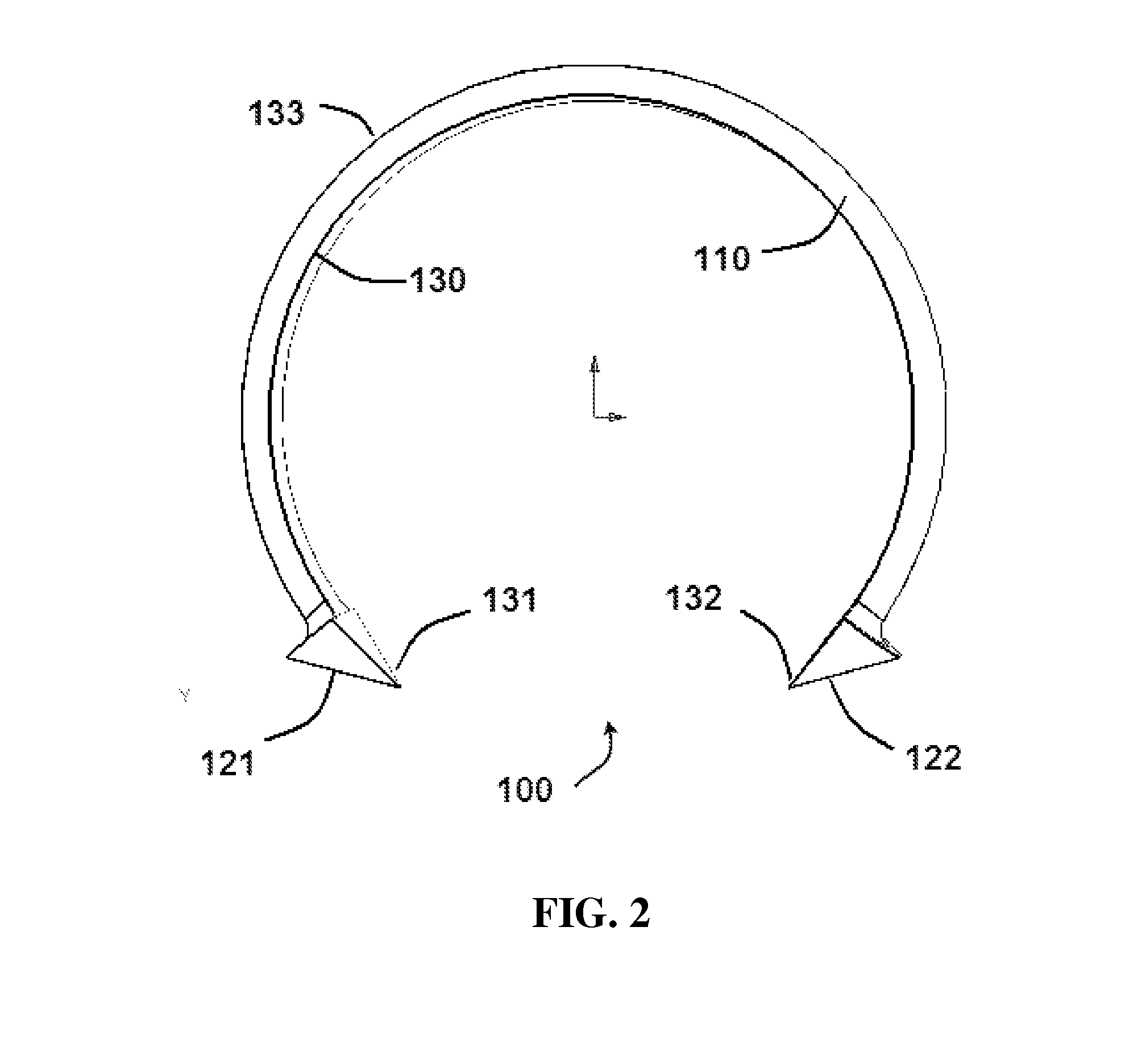[0007]Embodiments of the present invention may be used to address a need in the art for an effective
system for closing mucosa, particularly mucosa of the
oral cavity, oronasopharynx, hypopharynx, or laryngeal surfaces. Such a
system preferably provides for the effective closure of mucosal tissues without dehiscence. The system may be used in
surgical procedures of the oronasopharynx (e.g., UPPP, tonsilectomy, uvulopalatal flap (UPF) technique,
dental procedures, laryngectomy, pharyngectomy, esophagectomy,
tumor removal, etc.). Embodiments of the present invention provide such devices for the effective closure of mucosa as well as instruments for the delivery of these novel fastening devices and methods of using such devices and / or instruments. Embodiments of the present invention save time and can lead to better outcomes than current
suturing techniques. For example, embodiments of the invention may reduce dehiscence rates, reduce bleeding, reduce pain, speed healing, reduce surgical time, and / or improve
sleep apnea score results.
[0015]One of the many advantages of the inventive system is that it offers physicians an alternative to suturing, which has the problem of a
high rate of dehiscence, bleeding, pain, and other complications. The inventive system allows for the efficient closure of mucosa, particularly in the oronasopharynx, the
oral cavity, oropharynx, hypopharynx, and laryngeal surfaces. Overall, the inventive system can reduce surgical time, thereby reducing the time a subject is under
anesthesia, and improves surgical outcomes.
[0025]The inventive fastening devices for use in approximating mucosa or other tissues are designed to reduce or prevent tearing of the tissue or other damage to the tissue. Although suited for use in closing or approximating mucosal tissues, the fastening devices may be used in other non-mucosal tissues. Embodiments of the device may also be used to approximate a mucosal surface to a non-mucosal surface; to approximate a mucosal surface to non-mucosal surface; or to approximate a non-mucosal surface to a non-mucosal surface. Embodiments of the fastening device may be of a variety of shapes and sizes. In certain embodiments, the device is angled, curved, semi-circular, oval, C-shaped, V-shaped, U-shaped, L-shaped, or D-shaped with parts for attaching the two ends of the device to form a ring-like structure. In certain embodiments, the parts for attaching include a female and male end. Embodiments of the device may also be designed like a
rivet with two separate and male and female pieces which can be fastened together. In order to minimize the tearing of mucosa by the fastening device, certain embodiments do not include a round cross-sectional area. Instead, the cross-section of certain embodiments of the device is flattened, oval, polygonal, rectangular, or square. In particular embodiments, the cross-section of the part of the device penetrating the tissue is flattened, oval, polygonal, rectangular, or square. Such a cross-sectional shape reduces the likelihood of the device from tearing through the tissue which has been closed. The device may be one piece molded from a biocompatible, bioresorbable polymeric material.
[0031]In certain embodiments, the invention also provides an instrument for fastening or closing tissue using the inventive fastening devices. In certain embodiments, the instrument is designed for use in the oronasopharynx. In certain particular embodiments, the instrument is designed for use in a particular procedure or
surgery. In certain embodiments, the instrument is designed for use in spaces of the
head and neck. For example, an instrument may be designed for closing the tonsillar fossa in a tonsillectomy or UPPP with or without tonsillectomy. In certain embodiments, the instrument is designed for use in a UPF procedure. In certain particular embodiments, the instrument is designed for use in closing a pharyngeal flap. In certain embodiments, the instrument is designed for closing a laryngeal or pharyngeal defect. In certain embodiments, the instrument is designed for use in
tumor removal. In certain embodiments, the instrument is designed for use in a
dental procedure. The instrument may include a long neck for reaching spaces in the oronasopharynx. The instrument may also be relatively thin and / or compact for operating in such confined spaces. The instrument may include a comfortable
handle with a triggering mechanism for fastening the inventive fastening device around approximated tissue(s). The instrument may include a plurality of fastening devices. For example, the instrument may include at least 5, at least 10, at least 15, at least 20, or at least 25 of the fastening devices. In certain embodiments, the fastening devices are provided in a cassette for easy re-loading of the instrument. In certain embodiments, the instrument includes a mechanism for automatically engaging a new fastening device after one has been placed. In certain embodiments, the instrument includes a mechanism for fastening the fastening devices after tissue has been engaged. In certain embodiments, the instrument is disposable. In other embodiments, the instrument is suitable for sterilization after each use. Therefore, the instrument may be repeatedly used by reloading the instrument with fastening devices or cassettes of fastening devices.
[0036]In certain embodiments, the first fastening member and the second fastening member are configured to be coupled together. The body may comprise a hinge so that the first fastening member can be brought closer to the second fastening member. In certain embodiments, the device is made of a biocompatible, bioresorbable material. The device may be coated with a
protein or
growth factor-based product to enhance healing of the tissue during use.
 Login to View More
Login to View More 


